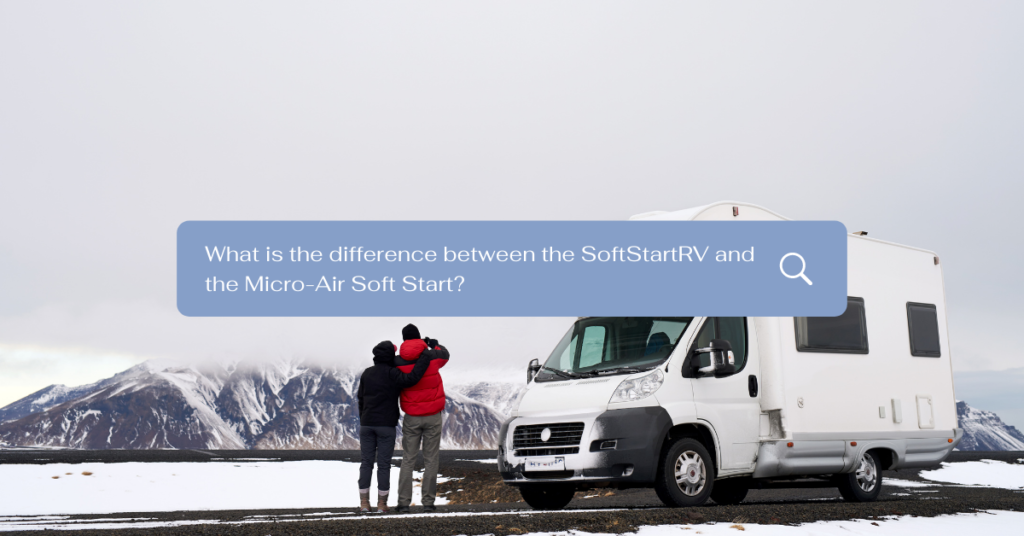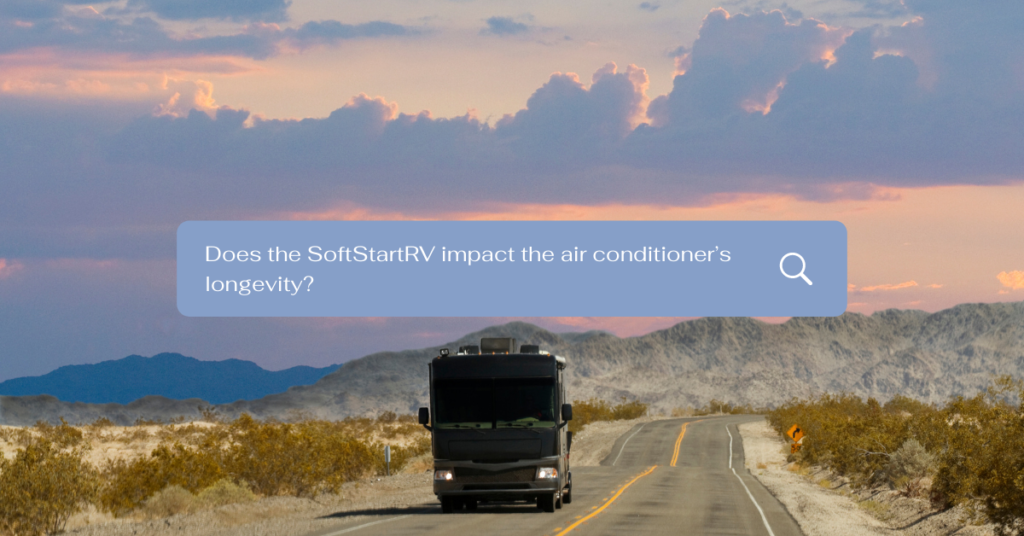Your Soft Start Questions Answered
"Ask The Expert" Q&A With Mike Sokol + Engineer Danny Rahner Live Video Interview
Interested in purchasing a soft start for your RV? Fortunately, SoftStartRV’s Director of Technical Support Danny Rahner sat down with Mike Sokol of RVElectricity to answer frequently asked questions from RVers, Airstreamers, and campers on the SoftStartRV, covering all aspects of installation. Watch the livestream video, or get all the information in this transcription.
In this guide, we will review:
Table of Contents
Mike Sokol (00:10:27):
Hello everybody. Yep. Go get rid of that stuff. How’s everybody doing out there in,I guess electronic land.
So let me just get into my next slide here. first off, I just want to,we’re going to welcome expert Danny Radner, from SoftStartRV. I’m Mike Sokol from RV Electricity. You guys know me from all my variety of things that I’ve done, right. I’d also like to thank RVtravel.com for supporting this webcast and, promoting it all week.
So let us know where you saw this from. Can I save this? Yes. You’re going to be able to see this later. You can see this as many times until you’re sick to death of us, so not to worry. Okay. So I’m going to bring in Danny right now. So Danny, there you go. You should be hot to go. So let’s just say howdy. Hi to all the people out there, man. I got a lot of people online already. Wow.
Danny (00:11:25):
Sounds like a good idea.
Mike:
Okay. So Danny, where are you? You’re located right now? Where it’s cold. Are you not?
Danny:
Yes, I am located in El Paso, Texas. Where it is presently cold.
Mike:
I’m just up in Maryland, not so bad. I’m trying to stay warm here, but all good so far. I, everybody says have a good night, stay warm, and warm wishes everybody out there. Warm wishes. Okay, so let’s go ahead. Yeah, I’m going to take questions on here. First off, I’m going to start up a PowerPoint. I’m going to explain a little bit about what a SoftStartRV is. And we’re going to see what kind of questions we got and then Danny’s got some PowerPoint slides up here he can discuss about it.
So I’m going to talk a little bit about it and then I’m going to put it back to Danny and then we’re going to go take your questions.
So first off SoftStartRV. You guys may remember this, this actually got me interested about six months ago into actually building a really unique test device, which I call a hurdle and a high rate data logger. I use my audio background plus my calibration background when I used to build nuclear guidance systems, plus all my other weird backgrounds. And so I built a device that would allow me to log data at a very, very high rate.
In fact, this one I’m able to do at 190 to 2000 times a second, down to one part per million accuracy. And with that, I was able to create this really, really interesting graph.
And you can see I came up with all of this. This is not some artist’s idea. This is me actually drawing this stuff out, you know, right from the data.
(00:13:16):
So a regular RV compressor standard, 13,000, 13,500 or 15K, something in that order. We’ll have right around, around a 52 amp peak current with a stock capacitor, that’s just to kind of bump it, to get the thing started. And that has a number of problems because it can cause generators to kick out. It caused circuit breakers that are close to the limit to trip. And so SoftStartRV when you install it, if you look at the yellow line on the graph, it has a much lower ramp up. So instead of a 52 amp peak, it’s like a 24 amp peak current. You can notice this is only a tiny fraction of a second, 150 milliseconds is like faster than you can blink.
Same way with 330. That’s about a third of a second, less than a TikTok. So this thing does this, anytime it starts up, it does this slower ramp up. So you don’t hear it do a big bump, but it will allow you to run generators off air conditioners off of smaller generators.
So now I’m going to back up a shot here and get Danny back in. And I say hello from Canada lava light. Yes. Everybody loves the lava lamp in the background. Sorry to distract you.
So Danny, what else can you tell us about general operation of SoftStartRV?
Danny (00:14:54):
Well, as far as operation, it, it does. Yes. It allows you to run off of the lower amperage. Therefore you can, you can run, you have no problem running both your A/Cs anymore off of a 30 amp breaker. It’s, it’s something that RVs have needed for many, many years. And, and I was really happy when I saw this come along. So I’m looking forward to questions.
Mike (00:15:30):
Okay. So tell them a little bit about your history, your background and all of this sort of thing. How, how did you get here?
Danny (00:15:37):
Well, I’ve got a background as an IT and manufacturing engineer, 45 years. I’ve made everything, spent 30 years making your water heater and furnace controls for both residential, commercial, and RVs. I spent several years making rare earth magnetic drives and various other devices with extremely strong magnets and then seven years actually with Dometic as Senior Manufacturing Engineer over all A/C and Marine refrigeration lines. And from Dometic, I went to work for the government Senior Engineer, making the instructions on how to assemble, disassemble, and disarm anti-tank bombs. So that’s pretty much my background.
Fun stuff. Okay. So if you guys have questions, go ahead and send them over and then I’ll be, get, be glad to pop them up here. I’ve got a bunch of just general stuff happening here, but send a question over. So I guess now… I’ve installed one of these on a Dometic. What is a penguin? 2K I guess, on my back porch here and you know, I’m, I’m doing it down on the ground.
How complicated do you think this is for the average person to do?
FAQ 1: How complicated is it for the average person to install a SoftStartRV?
In this section, Danny will answer:
Will the SoftStartRV work with any air conditioner?
Danny (00:17:11):
This is extremely easy. It doesn’t matter what air conditioner it is. There’s only going to be six steps. I always tell people if you can count from one to six and if you can differentiate the five colors it should only take you, It’s going to take you longer to get your wires pulled into your electrical box and crimp what I use as disconnect fittings, it’s going to take you longer to get that in the box than it will to do the main installed. That should only take you about five minutes maximum.
Mike (00:17:50):
Okay. One of the things that, I’ve used on mine and I see a number of the manufacturers are doing it, is something that’s called there’s WAGO connector. There’s a little lever action connectors. I tend not to like the twist nut stuff. I mean, we do that a lot, but what do you, what do you guys recommend for hookup in your installs?
In this section, Danny will answer:
Should I cut my wires if my unit is under warranty?
What if something goes wrong with my AC and I need to replace it?
How long does it take to uninstall a SoftStartRV unit?
Danny (00:18:12):
I recommend using the spade connectors, which is what’s located on your wires currently… I do, I prefer not to cut wires. And if you’ve got a unit that is under warranty, I refuse to let you cut wires. That’s why I try to use the same thing that they do. And this way, if something goes wrong with your AC… and you need to replace your AC. In a matter of about three minutes, you can have your soft start out. And if something was to go wrong with a soft start, I can have you back to factory settings. Like I said, three to five minutes, you still have an air conditioner until you get hold of me, and I can get you a new one shipped out to you.
Mike (00:19:11):
Okay, Danny, I’ve got a couple of questions here. So one is, it says, can you spell the type of connectors you recommend?
FAQ 3: What kind of spade connectors do you recommend for a SoftStartRV installation?
In this section Danny will answer:
Does my SoftStartRV kit include spade connectors?
Where can I buy the spade connectors for the SoftStartRV if needed?
Danny (00:19:19):
Yes, these are called spade connectors. You can, you can pick these up. I know your kit comes with them, but right now we’ve got a couple of kits out there, the old way of doing it. They did use splice connectors, which meant you cut wires. Then when I started, we went to these connectors and for $3, Lowe’s carries these things. It’s called a 12 10, because you’ve got a 12 gauge wire. So it’s a 12, 10 male-female disconnect package with 16 of these connectors in a package for $3. Lowe’s carries them, Home Depot carries them.
Mike:
Okay. So I’ve got a one here from Trevor. I purchased a soft start. I have a 15,000 BTU air conditioner on my micro mini Winnebago. What size generator would I need to power it?
FAQ 4: What size generator would I need to power a SoftStartRV for my 15,000 BTU air conditioner on my Micro Minnie Winnebago?
Danny: The 15 K yeah. Okay. Here, here’s the thing you can, you can run off of small – It depends on your preference, because what the smaller generators, what you’re going to do is yes, you can run it off of the small generator, but you really, I mean, if you’re only after AC maximum, I would say would be 2,800 watt, just to be safe. That gives you a little bit of bumper there.
You can, you can go down and a 2200 watt would run it, but you’ve got to remember the only thing you’re going to be able to run is your AC. So I always tell people don’t undersize yourself. And before we’re done here, we can give my personal email out and I can send you a little thing that I’ve made. And all you’ve gotta do is plug in this. And it will give you, you plug in and you say what your starting amps are, or Watts are, on a compressor and what your running amps are. And that would pretty much tell you what you can run off of a generator.
Mike (00:21:46):
Well, Danny, if you send that to me, I’ll go ahead and post it right up on this page and anybody that wants it can get it. How’s that?
Danny (00:21:54):
Well, it’s a, it’s an excel file,
Mike (00:21:59):
Right? Well, we’re not going to do it right now. We’ll do it at the end. Okay. I got a ton of questions. Let’s keep rolling here. So George Penningtons, what is the difference between the SoftStartRV and the Micro-Air soft start? What’s the difference in operation between those two?
FAQ 5: What is the difference between the SoftStartRV and the Micro-Air Soft Start?
In this section, Danny will answer:
Do the SoftStartRV and Micro-Air Soft Start operate differently?
How long should I wait until I see the green indicator LED light turn on?
How do I know my SoftStartRV is running properly once installed?
Danny (00:22:14):
Okay. As far as operation, there’s not a whole lot of difference there. But the difference between the Micro-Air and the SoftStartRV is they’ve got a four wire system. They ended up cutting more, they cut quite a few wires and twist them together, where we do not. Ours is an easier install. Because like I said, I’m not cutting wires.
Mike (00:22:47):
One of the things that I’ve also noted, the Micro-Air does require you to go through a learning curve and start the thing, like five times in a row, whereas SoftStartRV has a built-in curve that you just turn it on and it works.
Danny (00:23:03):
Okay with the, with the, with the SoftStartRV. What I tell people to do ,when I go through the thing is, I asked you when you first get ready after you do your install, I tell you in the instructions to turn your fan on high… And then all’s I’m doing with that is that tells you, you do have power up on your AC, because we do not touch anything in the wiring that would affect your fans. So if your fan is not working, you’ve done something that you shouldn’t have. I only show you the wires that you’re going to touch. That way, it takes confusion out it.
So anyway, I tell you, turn your fan on high. As soon as you hear the fan on high, that means you’re, you’re good to go. And then you set your thermostat to Auto Cool. Turn it down as low as it’ll go. You go back up, you look at your soft start, you’ve got a green light. You’re good to go. You, you could close everything up and, and…run the thermostat up to near ambient temperature. Let it run for 30 minutes. And you’re good to go from then on.
Now, another thing with the soft start, some units go into a three minute test mode, not all, but some of them do so you, if you go up there, you don’t immediately see any lights. I tell you wait to full three minutes. After four minutes, if you don’t have a green light, then you call me and we’ll go over it and get you going.
Mike (00:24:45):
Okay. Now very good. So Patrick asks, if you do not have a soft start, how long will the RV AC last with a 30 amp system? If you do not have a soft, I have a 2018 Coachmen too. I’m not sure. What does that mean? You mean in terms of longevity? Patrick have you’ll respond a little better. I’m not quite sure what that means. Do you, Danny?
Danny (00:25:12):
Well, I think he’s worried about it. I mean my parents have a, a class C that has a brisk unit on it. That is probably 25 years old and it still works like the date came off the showroom. So but the thing is, it still has the loud “thump”, with the SoftStartRV, you don’t get that knock.
Mike (00:25:47):
Right. And if you go back to the graphic that I did, that first jump is when you’re kind of hammering on the compressor, as opposed to kind of like a “whoosh”. And I looked at it like, instead of like, dropping, revving up your car and just dropping it into gear, you it’s more like an automatic transmission where it’s just like smoothes the thing up over about a third of a second.
Danny (00:26:08):
I’ve actually had customers tell me… It’s a funny story. I had a gentleman that installed it on a Dometic Brisk unit, and they’re notorious for having that loud knock. And this gentleman was actually standing over the top of the unit and told his wife, “turn it on”. And he says, “It didn’t come on”. And I said, “Do you have a green light?” And “Yeah”, I said, “Green light means your compressor is running. Your unit is running.” He says, “No, I didn’t hear it come on.” Right. I said, “Reach down and touch the tube.” And he said, my goodness, he says, “The blower motor is now louder than the compressor.” So it makes a huge difference.
Mike (00:27:01):
I noticed this with the thing running down on a pair of saw horses right beside me. And the only way that I can tell if the compressor’s on or off is, I’m just looking at the amperage draw on one of my meters. Okay.
So, Oh, here’s another one. Here’s a good question. So, George Pennington (says) is there a difference in the units for different ACs or is it pretty much one unit? You just wire them up differently?
FAQ 6: Are there different types of SoftStartRVs for different ACs, or is it the same product for every AC?
In this section, Danny will answer:
Do you need to buy a different soft start depending on what type of AC unit you have, or does the same SoftStartRV function for all AC units?
Do you wire the SoftStartRV differently depending on what kind of AC unit you have?
What AC unit brands do you have wiring diagrams for?
How do I find out what type of AC unit I have?
What if you don’t have a wiring diagram for my AC unit?
What is the most important thing to remember while installing a SoftStartRV?
Danny (00:27:28):
It’s the same unit, but depending on your AC, it would be a different diagram. That’s why I’ve got 36 different schematics.
Most of them are, I’ve got four of them that are, five of them that are …Dometic units. The rest of them are all Coleman, and I’ve got a Marine and then I’ve got three GEs got one, Atwood’s got one, and a Carrier.
But, but to your answer now, here’s the thing: If you’ve got a Coleman unit you take your, your outside shroud, you’d take the shroud off, find your electrical box. And inside the lid of that electrical box, there’s going to be a yellow schematic on one of the bottom corners. They’re going to be a 1976. There can be a letter anywhere from an A to E, N, E and possibly even beyond and then three numbers. That would give me the exact schematic you’ve got.
If it’s one that I don’t have, if you send me a picture of that schematic, I will draw you the schematic and get it to you ASAP. It usually takes me about an hour to draw one, but then once I give you the schematic and you’re ready to do this, I ask if you were to call me, I will be more than happy to walk you through it, Step-By-Step. That way you’re not so intimidated by it. I’m going to lead you exactly what you’ve got to do.
The most important thing you got to remember when you do this is – you’ve got a white compressor wire. You must follow that to your electrical box, to the run capacitor because you got white fan wires there. And if you get the wrong, a white wire, your fan can come on, but your compressor will come on. Cause you didn’t get the right wire.
But other than that from then on, it’s pretty straightforward. It’s very simple, which we’ll get here and can show you one of the most basic schematics so that you would understand how this goes.
Mike (00:30:18):
Okay. So let me do a couple more questions and then we’ll throw one of your schematics up. How does that sound? Patrick, he says, yes, he was talking about the longevity of it. I know a lot of people who’ve asked me if it helps an air conditioner compressor last longer, and I say, I can’t hurt because there’s less stress on it. But again, I don’t know of any actual studies that show whether this, you know, lets the compressor last longer.
FAQ 7: Does the SoftStartRV help the air conditioner compressor last longer?
In this section, Danny will answer:
Does the SoftStartRV impact the air conditioner’s longevity?
Danny (00:30:48):
It should. It’s it’s got you because it’s not getting slammed with the giant jolts that it normally would, therefore… it should in all aspects, make it last longer.
Mike (00:31:05):
That’s you know, everything that I know about compressors and physics in engines kind of hints at that. People have said, “Well, why don’t you set up a test to run it?” And I’m going, you know how many hours I’d have to run stuff like that to know? (laughs)
Danny (00:31:20):
Well let me, let me put it this way. It’s like..That’s why you’ve got surge protectors. Surge protectors are there to stop that sudden mega jolt of power coming in, ‘cause it does shorten the life of electronics. And your soft start acts like a surge protector.
Mike (00:31:44):
Okay. So I’m going to one other question here, and then we’re going to go to the schematics here. So this is Mike Zimmerman, Mike Z, one of the Mikes here on my RV Electricity group.
So he’s asked, can you ask Danny to explain in a little bit of detail, how and why, and he’s talking about the micro air unit, Why do they go through a few learning cycles? Yours does not, but why do they have to go through this learning cycle stuff? Do you know?
In this section, Danny will answer:
Why do other soft starter brands require a “learning cycle” and SoftStartRV does not?
Danny (00:32:12):
That, I don’t know, other than their electronics that they’ve got in there…Well, I’ve actually installed one for a guy. Even though it’s my competitor, the gentleman was in trouble, so I helped him install it. But they, they must have something in their system that requires it to, to learn, to see, I don’t know how it does that, but ours. No we don’t.
Mike (00:32:48):
Okay. So now you want me to put a point of these slides? Which one would you like me to put it up for?
Danny (00:32:53):
Let’s put the (Dometic) Brisk up, this way, people understand… I want to explain something to them. Okay, this is probably the easiest way to explain things on there.
Click here to view Dometic Brisk I and Dometic Brisk II Schematic
FAQ 9: How do I read my wiring diagram?
In this section, Danny will answer:
How many wires does a compressor have?
What do the letters on my wiring diagram stand for?
What is the first step in reading my wiring diagram?
How do I read a wiring diagram for my Dometic Brisk I unit?
How do I read a wiring diagram for my Dometic Brisk II unit?
How do I know if my unit has a start capacitor?
How do I wire my SoftStartRV step by step?
What do I do if something goes wrong with my soft start?
How do I uninstall my SoftStartRV?
How long does it take to disconnect a SoftStartRV?
How do I uninstall my SoftStartRV if my AC unit is under warranty?
Danny:
I tell people, all compressors have three wires.
You’ve got an “R” which stands for run.
You’ve got an “S”, for start.
And then your common, your “C”.
Your R always goes to the C of your run capacitor, the common on your run capacitor.
The S always goes to the start or the Herm side of your run capacitor.
And then your common, your compressor wire, that goes down into normally would go down into your cabinet. But as you’ll see, when I go to the next slide, that it’s different.
- Step 1: So this one is showing you, always first step is follow your white compressor wire to your run capacitor. All you do is disconnect it off the C terminal on the run capacitor.
You put a male fitting on your blue, soft start wire and plug it into it… Then when we’re done, I would ask you to put electrical tape when we’re done, after we’re done testing the unit.
- Step 2: Your second step is you take your black soft start wire. You put a female fitting on that and you put it on the terminal the white wire came off of.
- Step 3: You got a yellow soft start wire that you would put over on a Herm terminal next to your red compressor wire.
- Step 4: Now units like the Brisk do not have start capacitors 99.9% of the time, but should it have a second red wire next to your red compressor wire – That would be an indication you would have a start capacitor.
All you do is simply disconnect that wire you tape it and drop it. So that would be step four.*If you don’t have that second red wire, you skip step four.
- Step 5: On this Brisk unit, you would:
- Find your blue compressor wire. And at the top of your compressor, go down… say 10 inches or just where you’re safe, so you’ve got some room from the top of the compressor.
- And if you’re out of warranty, I say, okay, you can cut that wire – on that blue wire that goes back up to the compressor, you would put a female fitting.
- On the other end of the blue that you just cut, you put a male.
- On your brown soft start wire, you put a male on that. That connects to the blue wire that goes to the top of the compressor.
- Your red soft start wire gets a female. That connects to the blue (wire) that goes down into your cabinet.
Now, the reason I do this is, should something go wrong with your AC, you want to pull your soft start out. It takes you three minutes to disconnect these fittings, and you’ve got your soft start in your hands.
The other thing it does is should something go wrong with the soft start, I can have you…go back over your steps and
- Take your blue wire and your white wire. Take that apart.
- Pull the black wire off
- Put your white wire back where the black one just was
- Pull your yellow soft start wire off,
- Take and disconnect your red and brown soft start wires from your blue wire.
- And you just plug your blue wire back together
Now Coleman uses a white, red and black…And then I also have a chart that one of these days I can, I can give to show. But the most common are your red, white and blue. Dometic likes to call that the patriotic wires. Coleman uses, typically, a red, white, and black.
Danny (00:37:46):
So this just shows you how simple it is to do this. And on the schematic, you can see, I show you the fittings that it requires and how many it should take.
But now, if you’ve got a unit that is in warranty, what I would do is:
- Have you take the cap off the top of the compressor.
- You disconnect your blue wire from the overload.
- And instead of putting a male fitting on your brown soft start wire, you would put a female fitting.
- So you put the wire in, crimp the wire, and then bin that female fitting at, say, a 45.
- The reason why, if you don’t, it stands too tall and you can’t get the cap back on.
- Then you put a male fitting on your red, soft start wire.
- And all you do is simply plug it into your blue compressor wire, tape it up.
And that way you have cut no wires. And, and so a unit that is in warranty, I will not allow you to cut a wire.
Mike (00:39:07):
Okay. Want to go back and take a few more questions?
Danny:
Yes. Okay.
Mike (00:39:14):
So let’s see here. Okay. So here’s one, I think I might be able to help answer. And Michael said Michael Bracewell, another Michael, the travel trailer guy. “I have a 2016, 13,500 BTU air conditioner unit on our travel trailer. Would a 2000 Watt Wen inverter generator be able to operate the AC with the soft start? Thank you.”
And I think you two had talked about that. Yeah, and you can probably get away with a 2K, but it all comes down to: “Do you want to run other stuff at the same time?” Becomes the issue.
FAQ 10: Would a 2000 Watt Wen inverter generator be able to operate the AC with the soft start? I have a 2016 13,500 BTU air conditioner unit on our travel trailer.
In this section, Danny will answer:
What are the potential issues with using a smaller generator?
- How your altitude above sea level affects your generator’s efficiency
- How high temperatures affect your AC
- How to take care of the gas in your generator
- How to handle your carburetor in high altitudes
Danny (00:39:57):
Okay. Here, here’s another thing with that. Yes. You can run that on there, but here’s what you’ve got to keep in mind with, with the small one like that – For every thousand feet you go above sea level, you will lose 3.5% efficiency in the generator.
Also high temperature causes your gases in your AC to want to expand. And then the amps drive up, therefore making it a little bit harder to get going.
The other thing with the smaller generators, you’ve got to be a little bit more disciplined. You’ve got to make sure that you’ve got good gas in there all the time. So I would suggest after you’re using it say you used it for a weekend. I would drain the gas out of there. I would run the generator until the carburetor runs out of gas. Yep. You gotta run them dry.
Mike (00:41:10):
You’ll like this. Here’s your followup question here: “My Honda ED2200i struggles to run my 13,500 BTU air conditioner at 4,000 feet in a hundred degrees, fahrenheit degree day, with a soft start.”
Here, there you go. The higher you get up, unless you’ve got a turbocharger on that thing or a fuel injection.
Danny (00:41:32):
Well, you would have to, the only way you can do that is… I actually had a gentleman that said,
“I spend a lot of my time up Alpine camping”. He was in Utah. He says, “I spend it over at over 6,000 feet”.
I said, “Well, the only thing you can do then would be to reject your generator, right. The carburetor.” And I said, “But then you’re going to have that same issue when you go down to the flat lands, because then you’re going to be running too rich.”
So the thing is with, with that right there, I would suggest cleaning…have the carburetor clean. But then you’ve still got to remember, you’ve got that altitude working against you.
Mike (00:42:20):
Okay. Here’s a quickie. “I have a Roadtrek. Would this work?” I guess it depends what you have for an air conditioner, right?
FAQ 11: Will the SoftStartRV work for my Roadtrek?
In this section, Danny will answer:
Will the SoftStartRV affect my heat pump?
Danny (00:42:31):
You know what, and this is what – it doesn’t matter. Now, all air conditioners, like I said, all air conditioners have a compressor. All air conditioners have a run capacitor. Not all air conditioners have start capacitors, but that really doesn’t matter.
Now another thing to throw in here people ask all the time, well, I’ve got a heat pump. This will not affect your heat pump operation at all, because we do not touch any of the wiring for your heat pump.
Other than, just so that some people know, Coleman sometimes uses the start capacitor as the common for their reversing valve on their heat pump. But all’s, we’re doing is taking the positive wire off there and disabling the start capacitor that way.
This is Part 1 of our 2 part blog post series on Mike Sokol’s “Ask The Expert” video livestream.
Read more testimonials of the SoftstartRV from Airstreamers and RVers here. Have a review you’d like to share? Email us!
Help us get the word out about SoftStartRV by reviewing us on Google and Facebook. Your support helps us continue to provide the five-star customer service you love for a quality RV product.
Ready to start living the life you want in your Airstream?
Become a member of the NetworkRV family and order a SoftStartRV. We deliver on our promise to keep your Airstream or RV cool. With free tech support, free extended warranty, and 100% money back guarantee for 90 days, our special discount beats competitors and gives you the peace of mind to buy with confidence.
Trust has to be earned and we want to earn it
We appreciate the faith and trust you have placed in us in purchasing and using our SoftStartRV. More and more we’ve come to understand that we are a referral-based business. Hence, we appreciate and encourage anyone in your life right now such as a father, mother, son, daughter, uncle, cousin, neighbor, or fellow camper that has a need to be cool anywhere in their RV, and needs THE BEST expert opinion or soft start solution. We promise you we will give them our preferential service. And even if they choose to NOT buy our products, we will still try and help them solve their RV cooling issues.
Because you referred us, we are ready, willing, and passionately able to serve the people that are important to you. We want to help make smart campers smarter by giving them the most thorough, most meaningful, professional soft start advice. We will provide for them solutions, recommendations, videos, diagrams, plus LIVE rooftop tech call support. We will treat them in an incredibly special way on how to stay cool anywhere, anytime in their RV.
So please feel confident in your recommendation of us. Trust has to be earned, and we hope we have earned that in you to a degree you feel at ease in suggesting that special person, or special dog or cat who may need camper cooling in hot weather. We trust our help will be sought without reservations, thanks to your sincerest recommendations.
Glossary of Terms For RV + Airstream Owners
Your air conditioner, or A/C as it’s abbreviated, circulates the air within your RV, 5th wheel, Casita, Airstream, trailer, or motor home. SoftStartRV serves as an accessory that works with your RV air conditioner to provide a more evenly cooled space, that starts smoothly and runs with the power needed to keep you cool.
Airstream is a popular brand of travel trailer built out of aluminum, on the road since the 1930s. It is one of the top known RV brands in the industry.
Amp, or amperage, is the base unit of electronic currents. Most RV air conditioners
A camper, also called a campervan, motor caravan, or caravanette is a van that has been converted in some way to accomodate basic living necessities, like beds and a kitchenette. A camper van will typically sleep 2 or 3 people.
A capacitor is a device inside an air conditioning unit. It is small, cylindrical and it supplies and controls electrical energy. The capacitor provides a high-voltage jolt to the blower motor, compressor, and fan motor. The high voltage jolt is around 400 to 600 volts.
Casita is a top brand of small travel trailers that are easily towed with small cars and trucks. The Casita brand was established in 1983.
A Class A Motorhome is defined as a conventional motorhome. It’s the largest and most luxurious of the motorized RVs.
Class B Motorhomes are often referred as camper vans. Best suited for small groups, they’re smaller and more fuel efficient than Class C motorhomes.
A Class C motorhome is similar to a traditional automobile. It looks like a van from the front and is built with a cab or a cut-away chassis.
A compressor is one element inside of your RV air conditioner, working with the condenser and evaporator to keep your AC blowing cold air.
A generator is typically used with an RV, Airstream, or other motor home to power your air conditioner unit. The most common portable generator brands you will see at campsites include Advent, Armstrong, Atwood, Carrier, Coleman, Dometic, and Furion.
A 5th Wheel is a type of RV that has a hitch, allowing the driver to tow it behind a larger vehicle. A 5th Wheel is preferred by many because it provides the space of something larger, without being a “house on wheels” like many RVs.
A trailer is a separate vehicle that is not motorized, meaning it will need to be towed by a motorized vehicle or RV. Trailers are split into many categories, most notably travel trailers, fifth wheel trailers, popup trailers or truck campers.
Find Us On Social Media:
Subscribe to our Youtube channel for tutorials on products and customer testimonials.
- Like us on Facebook for RV posts, contests, live videos, and more.
- Follow us on Instagram for more fun posts on RVing, contests, and surprises.
Follow @Network_RV on twitter to keep up with our posts on RV life, new products, news posts, and more.
Follow NetworkRV on LinkedIn for posts on RV industry news, lifestyle, RV jobs, and more.









